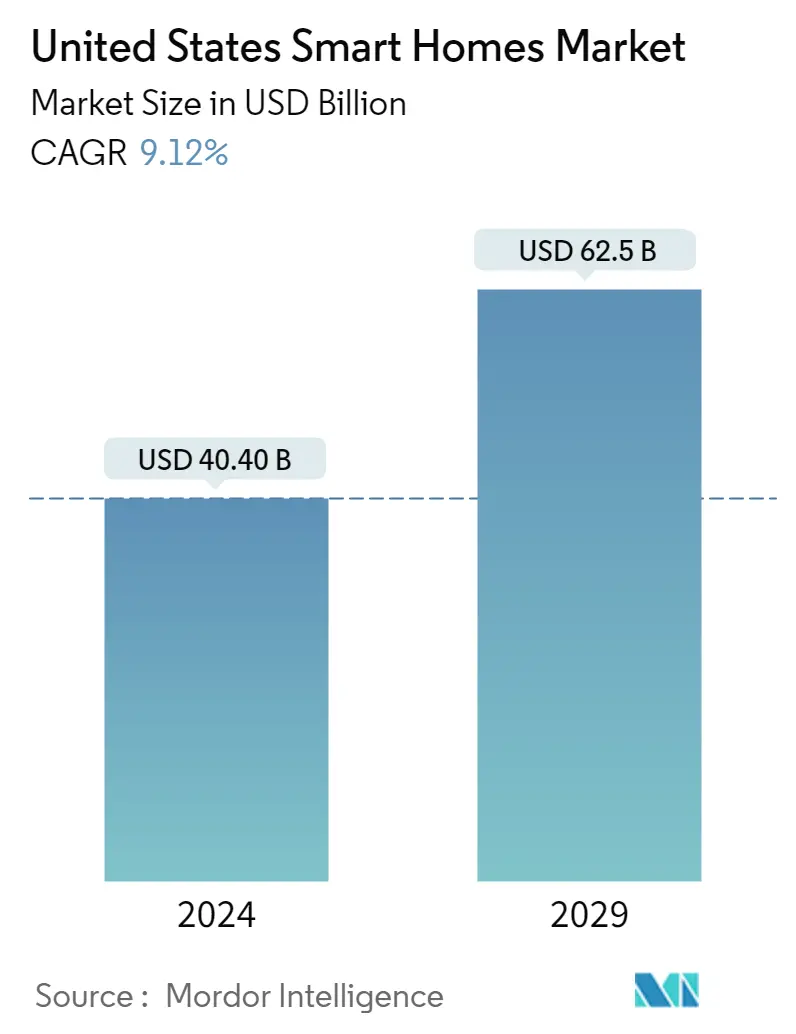Market Size of United States Smart Homes Industry

| Study Period | 2021 - 2029 |
| Base Year For Estimation | 2023 |
| Market Size (2024) | USD 40.40 Billion |
| Market Size (2029) | USD 62.50 Billion |
| CAGR (2024 - 2029) | 9.12 % |
| Market Concentration | Low |
Major Players
*Disclaimer: Major Players sorted in no particular order |
Need a report that reflects how COVID-19 has impacted this market and its growth?
United States Smart Homes Market Analysis
The United States Smart Homes Market size is estimated at USD 40.40 billion in 2024, and is expected to reach USD 62.5 billion by 2029, growing at a CAGR of 9.12% during the forecast period (2024-2029).
Home automation and smart homes are two ambiguous terms used for a wide range of monitoring solutions that control and automate functions in a home. Unlike simple home automation solutions (which could range from motor-operated garage doors to automated security systems), smart home systems require a web portal or a smartphone application as a user interface to interact with a computerized system.
- The increasing importance of the need to counter security issues is anticipated to fuel the demand for smart and connected homes over the forecast period. Moreover, innovative wireless technologies, including security and access regulators, entertainment controls, and HVAC controllers, are expected to foster market growth. The recent advancements in the Internet of Things (IoT), which resulted in price drops for processors and sensors, are expected to encourage manufacturers to promote automation in the household sector.
- In an effort to include more sustainable energy resources, household energy management is receiving a growing level of attention. Further, to reduce their energy costs, homes must become more efficient due to growing energy prices and increased demand. With the help of the Home Energy Management System (HEMS), the enablement of energy management services for effective monitoring and management of electricity generation, power conservation, and energy storage techniques are being developed for smart homes.
- Some smart devices like smart thermostats and their associated apps can assist users in receiving faster alerts when a heating or cooling system is experiencing issues. When a home warms or cools past a preset temperature, some smart thermostats let the user set alarms, potentially signaling system issues. As opposed to using a conventional thermostat, this functionality enables users to schedule service for a damaged or malfunctioning system more rapidly.
- Currently, the smart homes market refers to luxury projects. However, it is expected to become a requirement in all housing categories. The educated population is increasingly migrating to urban areas in search of jobs. With the desire to own a house in sync with the current trends, several people living in urban locations aspire for smart homes or homes that can adapt to evolving technologies. The sector is witnessing prominent growth due to its various advantages. Apart from the luxury segment, homebuyers from multiple components are expected to begin opting for smart homes and their benefits, with home automation being offered at affordable prices.
